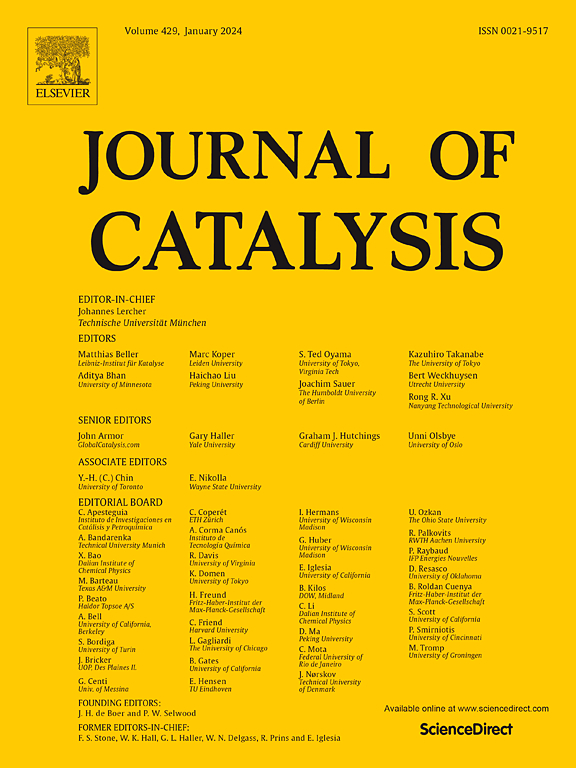Elucidating the role of solvent in C=C bond hydrogenation of maleic acid at metal-solvent interface by AIMD and DFT simulations
IF 6.5
1区 化学
Q2 CHEMISTRY, PHYSICAL
引用次数: 0
Abstract
Ab-initio Molecular Dynamics (AIMD) and Density Functional Theory (DFT) simulations were used to understand the solvent effects in C=C bond hydrogenation using maleic acid (MAc) to succinic acid (SAc) as a model reaction on Pd (111) surface. In the presence of explicit water molecules, MAc was observed to dissociate to maleate ion (MA). The presence of hydrogen bonding network in water and charge redistribution from the Pd surface to the water molecules stabilized the reactants and intermediates and resulted in low free energy barriers (31.7 and 44.9 kJ/mol) for the first and second step of C=C bond hydrogenation. Interestingly, the C=C bond of MA in presence of water was reduced by the surface H atom rather than the solution-mediated pathway. The surface H atom, however, could be either obtained by direct H2 dissociation or via H exchange between adsorbed H and nearby water molecules. The free energy barrier for the H exchange between nearby water molecules and surface adsorbed H atom was calculated to be 43.1 kJ/mol. In the absence of hydrogen bonding network in polar aprotic solvent like 1,4-dioxane and vacuum phase, the activation barriers were estimated to be relatively high. In general, the electronic effect of the solvents followed a linear trend, where FMO gap serves as a good descriptor of the reactivity.

用AIMD和DFT模拟阐明了溶剂在金属-溶剂界面马来酸C=C键加氢中的作用
采用Ab-initio分子动力学(AIMD)和密度泛函理论(DFT)模拟研究了以马来酸(MAc)与琥珀酸(SAc)为模型反应,在Pd(111)表面进行C=C键加氢时溶剂的影响。在明确的水分子存在下,观察到MAc解离成马来酸离子(MA)。水中氢键网络的存在和电荷从Pd表面到水分子的再分配稳定了反应物和中间体,导致C=C键加氢的第一步和第二步的自由能垒较低(分别为31.7和44.9 kJ/mol)。有趣的是,MA的C=C键在有水存在时被表面氢原子还原,而不是通过溶液介导的途径。然而,表面的H原子可以通过H2直接解离或通过吸附的H与附近的水分子之间的H交换得到。计算出附近水分子与表面吸附H原子之间H交换的自由能垒为43.1 kJ/mol。在极性非质子溶剂如1,4-二氧六环和真空相中没有氢键网络时,活化势垒相对较高。总的来说,溶剂的电子效应遵循线性趋势,其中FMO间隙可以很好地描述反应性。
本文章由计算机程序翻译,如有差异,请以英文原文为准。
求助全文
约1分钟内获得全文
求助全文
来源期刊

Journal of Catalysis
工程技术-工程:化工
CiteScore
12.30
自引率
5.50%
发文量
447
审稿时长
31 days
期刊介绍:
The Journal of Catalysis publishes scholarly articles on both heterogeneous and homogeneous catalysis, covering a wide range of chemical transformations. These include various types of catalysis, such as those mediated by photons, plasmons, and electrons. The focus of the studies is to understand the relationship between catalytic function and the underlying chemical properties of surfaces and metal complexes.
The articles in the journal offer innovative concepts and explore the synthesis and kinetics of inorganic solids and homogeneous complexes. Furthermore, they discuss spectroscopic techniques for characterizing catalysts, investigate the interaction of probes and reacting species with catalysts, and employ theoretical methods.
The research presented in the journal should have direct relevance to the field of catalytic processes, addressing either fundamental aspects or applications of catalysis.
 求助内容:
求助内容: 应助结果提醒方式:
应助结果提醒方式:


